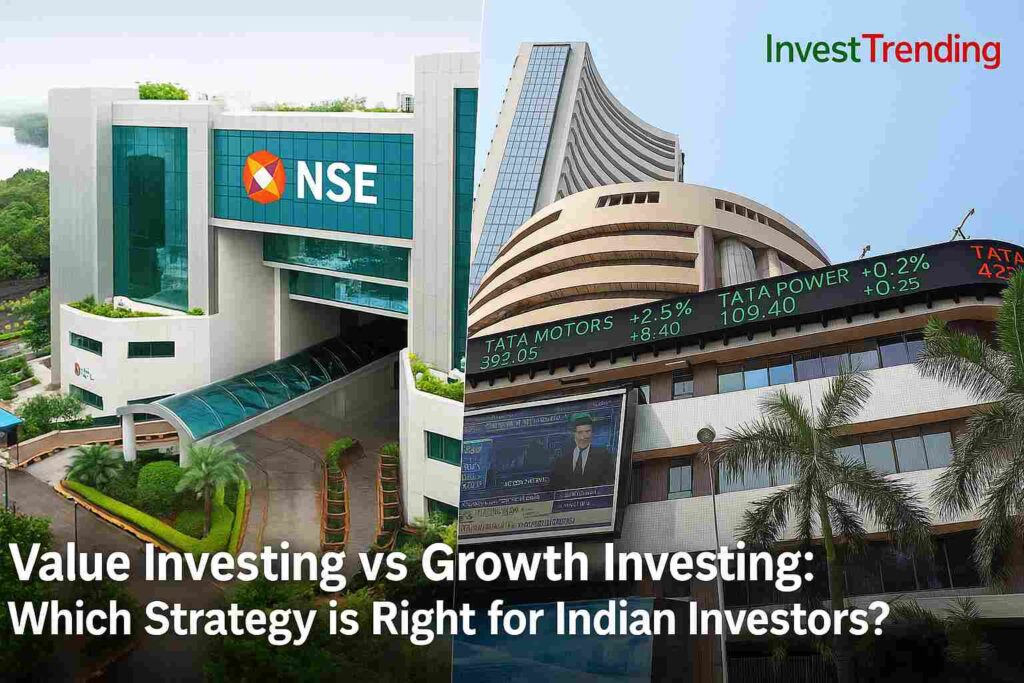
Value Investing vs Growth Investing
Investing in the stock market can be both exciting and intimidating, especially for beginners. Among the many strategies available, two of the most popular are Value Investing and Growth Investing. Each approach offers distinct advantages and drawbacks, and your choice should align with your financial goals, risk appetite, and market outlook.
In this guide, we’ll explore both strategies in the context of the Indian stock market, highlight their key differences, pros and cons, and help you determine which investment path aligns with your objectives.
What is Value Investing?
Value investing involves identifying stocks that are trading below their intrinsic or book value. These undervalued stocks often have strong fundamentals, such as consistent earnings, low debt, and capable management. Investors focus on companies whose prices are temporarily depressed due to market overreactions or short-term setbacks. They rely on fundamental analysis—reviewing financial statements and ratios like P/E and P/B—to spot opportunities. The strategy centers on buying low and holding long-term until the market corrects the mispricing, offering potential returns with reduced downside risk.
Key Principles of Value Investing:
- Undervalued Stocks: Target companies whose stock prices are below their actual value.
- Long-Term Holding: Typically held for 5+ years to realize full potential.
- Fundamental Analysis: Includes studying financial statements, earnings, debt levels, and management quality.
- Stable Businesses: Preference for companies with strong cash flows and consistent earnings.
- Contrarian Outlook: Often buying when others are selling.
Notable Value Investors:
- Warren Buffett – Global icon of value investing.
- Benjamin Graham – Author of The Intelligent Investor.
- Rakesh Jhunjhunwala – India’s most revered value investor.
Indian Examples:
- ITC Ltd. – High dividend yield and diversified business.
- Coal India – Government-backed, reliable earnings.
- Tata Steel – Cyclical but strong balance sheet.
What is Growth Investing?
Growth investing focuses on companies with strong potential for future earnings and above-average revenue growth. These businesses may currently trade at higher valuations—often with elevated price-to-earnings (P/E) or price-to-sales (P/S) ratios—due to their rapid expansion, technological innovation, or dominant position within a fast-growing industry. Growth investors typically prioritize capital appreciation over dividends, betting that the company’s reinvestment of profits will lead to substantial stock price gains. This strategy often involves investing in sectors like technology, healthcare, fintech, or renewable energy, where disruption and innovation drive exponential growth. While the rewards can be high, growth investing also carries greater risk, especially if the anticipated growth fails to materialize or market sentiment shifts.
Key Principles of Growth Investing:
- Focus on Earnings Growth: Seek out companies with expanding revenues and profits.
- High P/E Ratio: Willing to pay a premium for growth potential.
- Reinvestment of Profits: Companies often forgo dividends to fund expansion.
- Fast Capital Appreciation: Returns come from rising stock prices, not dividends.
- Innovation-Centric Sectors: Tech, fintech, pharma, and renewable energy are common targets.
Notable Growth Investors:
- Peter Lynch – Known for managing the Fidelity Magellan Fund.
- Philip Fisher – Emphasized qualitative factors and innovation.
Indian Examples:
- Reliance Industries – Expansion into telecom and retail.
- Tata Elxsi – Rapid growth in automotive tech and design.
- HDFC Bank – Consistent performance and market leadership.
Key Differences: Value vs. Growth Investing
| Feature | Value Investing | Growth Investing |
|---|---|---|
| Investment Approach | Buying undervalued stocks | Buying high-growth stocks |
| Risk Level | Lower, relatively stable | Higher due to price volatility |
| Price Metrics | Lower P/E and P/B ratios | Higher P/E and P/B ratios |
| Time Horizon | Long-term (5+ years) | Medium to long-term (3-5 years) |
| Dividend Expectation | Often pays regular dividends | Rarely pays dividends |
| Market Suitability | Works well in bear markets | Performs well in bull markets |
Pros and Cons of Each Strategy
Value Investing:
Pros:
- Lower downside risk.
- Income via dividends.
- Less affected by market hype.
Cons:
- Slower returns.
- Requires deep analysis.
- Can underperform in strong bull runs.
Growth Investing:
Pros:
- Potential for fast wealth creation.
- Exposure to innovative sectors.
- Ideal in booming economies.
Cons:
- Higher volatility.
- No dividend cushion.
- Prone to market corrections.
Which Strategy is Right for You?
Choosing between value and growth investing depends on:
- Risk Appetite: Value is more stable, growth is more aggressive.
- Time Horizon: Long-term investors may prefer value, short- to mid-term can opt for growth.
- Financial Goals: Seek steady income? Choose value. Want quick gains? Choose growth.
- Market Cycle: Value thrives in corrections; growth thrives in booms.
Hybrid Approach: Best of Both Worlds
Many Indian investors are increasingly adopting a blended strategy. This means holding a mix of both value and growth stocks. A hybrid portfolio might include:
- 50% Value Stocks: ITC, Coal India, Tata Steel
- 50% Growth Stocks: Reliance, HDFC Bank, Tata Elxsi
This approach balances risk with return and offers exposure to stability and innovation.
“Smart investing isn’t about timing the market — it’s about time in the market.”
Additional Insights: Navigating the Indian Stock Market
In India, retail investors are becoming increasingly independent and financially aware. Online platforms like Zerodha, Groww, and Upstox have made stock market access more affordable and user-friendly. These apps offer tools such as screeners, ratio analysis, and real-time data, enabling users to make informed decisions on their own.
Financial education is also on the rise, thanks to YouTube creators, blogs, and SEBI’s investor awareness initiatives. As a result, many Indians are shifting from relying solely on financial advisors to taking a DIY (do-it-yourself) approach. This trend marks a significant move toward financial independence and smarter investing.
Here are a few extra tips for Indian investors:
- Use tools like Screener.in to identify undervalued or high-growth stocks.
- Understand market trends, especially around budget announcements, RBI policies, and global macroeconomic changes.
- Diversify across sectors, not just strategies.
- Invest through SIPs if you’re new, to avoid market timing.
- Track your portfolio quarterly to rebalance according to performance.
With SEBI tightening regulations and improving transparency, both value and growth investing are becoming more viable for Indian retail investors than ever before.
Final Thoughts
Both strategies can build wealth — the key lies in aligning your investments with your goals and temperament. If you’re patient and analytical, value investing may be your path. If you enjoy researching trends and spotting the next big thing, growth investing may be a better fit.
Regardless of the path you choose, always conduct thorough research, avoid herd mentality, and stay invested for the long run.



